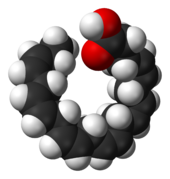
| |||
| |||
| Names | |||
|---|---|---|---|
| Preferred IUPAC name
(4Z,7Z,10Z,13Z,16Z,19Z)-Docosa-4,7,10,13,16,19-hexaenoic acid | |||
| Other names | |||
| Identifiers | |||
3D model (JSmol)
|
|||
| Abbreviations | DHA | ||
| 1715505 | |||
| ChEBI | |||
| ChEMBL | |||
| ChemSpider | |||
| DrugBank | |||
| ECHA InfoCard | 100.118.398 | ||
| EC Number |
| ||
| KEGG | |||
PubChem CID
|
|||
| UNII | |||
CompTox Dashboard (EPA)
|
|||
| |||
| |||
| Properties | |||
| C22H32O2 | |||
| Molar mass | 328.488 g/mol | ||
| Density | 0.943 g/cm3 | ||
| Melting point | −44 °C (−47 °F; 229 K) | ||
| Boiling point | 446.7 °C (836.1 °F; 719.8 K) | ||
Except where otherwise noted, data are given for materials in their standard state (at 25 °C [77 °F], 100 kPa).
| |||
Docosahexaenoic acid (DHA) is an omega−3 fatty acid that is an important component of the human brain, cerebral cortex, skin, and retina. It is given the fatty acid notation 22:6(n−3).[1] It can be synthesized from alpha-linolenic acid or obtained directly from maternal milk (breast milk), fatty fish, fish oil, or algae oil.[1][2] The consumption of DHA (e.g., from fatty fish such as salmon, herring, mackerel and sardines) contributes to numerous physiological benefits, including cognition.[3][4] As a component of neuronal membranes, the function of DHA is to support neuronal conduction and to allow the optimal functioning of neuronal membrane proteins (such as receptors and enzymes).[5]
Structurally, DHA is a carboxylic acid (-oic acid) with a 22-carbon chain (docosa- derives from the Ancient Greek for 22) and six (hexa-) cis double bonds (-en-);[6] with the first double bond located at the third carbon from the omega end.[7] Its trivial name is cervonic acid (from the Latin word cerebrum for "brain"), its systematic name is all-cis-docosa-4,7,10,13,16,19-hexa-enoic acid.
In organisms that do not eat algae containing DHA nor animal products containing DHA, DHA is instead produced internally from α-linolenic acid, a shorter omega−3 fatty acid manufactured by plants (and also occurring in animal products as obtained from plants).[8] Limited amounts of eicosapentaenoic and docosapentaenoic acids are possible products of α-linolenic acid metabolism in young women[9] and men.[8] DHA in breast milk is important for the developing infant.[10] Rates of DHA production in women are 15% higher than in men.[11]
DHA is a major fatty acid in brain phospholipids and the retina. Preliminary research has investigated its potential benefit in Alzheimer's disease,[1][12] and cardiovascular disease,[13] and other disorders.[1]
- ^ a b c d "Omega-3 fatty acids". Office of Dietary Supplements, US National Institutes of Health. 15 February 2023. Retrieved 6 March 2024.
- ^ Guesnet P, Alessandri JM (2011). "Docosahexaenoic acid (DHA) and the developing central nervous system (CNS) - Implications for dietary recommendations". Biochimie. 93 (1): 7–12. doi:10.1016/j.biochi.2010.05.005. PMID 20478353.
- ^ Calder PC (2016). "Docosahexaenoic acid (Review)". Annals of Nutrition and Metabolism. 69 Suppl 1: 7–21. doi:10.1159/000448262. PMID 27842299.
- ^ Horrocks, L. A.; Yeo, Y. K. (1999). "Health benefits of docosahexaenoic acid (DHA)". Pharmacological Research. 40 (3): 211–225. doi:10.1006/phrs.1999.0495. ISSN 1043-6618. PMID 10479465.
- ^ Sinclair, Andrew James (2019). "Docosahexaenoic acid and the brain- what is its role?" (PDF). Asia Pacific Journal of Clinical Nutrition. 28 (4): 675–688. doi:10.6133/apjcn.201912_28(4).0002. ISSN 1440-6047. PMID 31826363.
- ^ "Dictionary - Definition of DocosahexaenoicAcids". Archived from the original on 2013-07-07. Retrieved 2012-04-21.
- ^ The omega end is the one furthest from the carboxyl group.
- ^ a b Burdge, G. C.; Jones, A. E.; Wootton, S. A. (2002). "Eicosapentaenoic and docosapentaenoic acids are the principal products of α-linolenic acid metabolism in young men". British Journal of Nutrition. 88 (4): 355–363. doi:10.1079/BJN2002662. PMID 12323085.
- ^ Burdge, G. C.; Wootton, S. A. (2002). "Conversion of alpha-linolenic acid to eicosapentaenoic, docosapentaenoic and docosahexaenoic acids in young women". British Journal of Nutrition. 88 (4): 411–20. doi:10.1079/BJN2002689. PMID 12323090.
- ^ Malone, J. Patrick (2012). "The Systems Theory of Autistogenesis: Putting the Pieces Together". SAGE Open. 2 (2): 215824401244428. doi:10.1177/2158244012444281.
- ^ Giltay EJ, Gooren LJ, Toorians AW, Katan MB, Zock PL (2004). "Docosahexaenoic acid concentrations are higher in women than in men because of estrogenic effects". The American Journal of Clinical Nutrition. 80 (5): 1167–74. doi:10.1093/ajcn/80.5.1167. PMID 15531662.
- ^ Canhada S, Castro K, Perry IS, Luft VC (October 2018). "Omega-3 fatty acids' supplementation in Alzheimer's disease: A systematic review". Nutritional Neuroscience. 21 (8): 529–538. doi:10.1080/1028415X.2017.1321813. PMID 28466678.
- ^ Innes, Jacqueline; Calder, Philip (2020). "Marine Omega-3 (N-3) Fatty Acids for Cardiovascular Health: An Update for 2020". International Journal of Molecular Sciences. v (21): 1362. doi:10.3390/ijms21041362. PMC 7072971. PMID 32085487.

